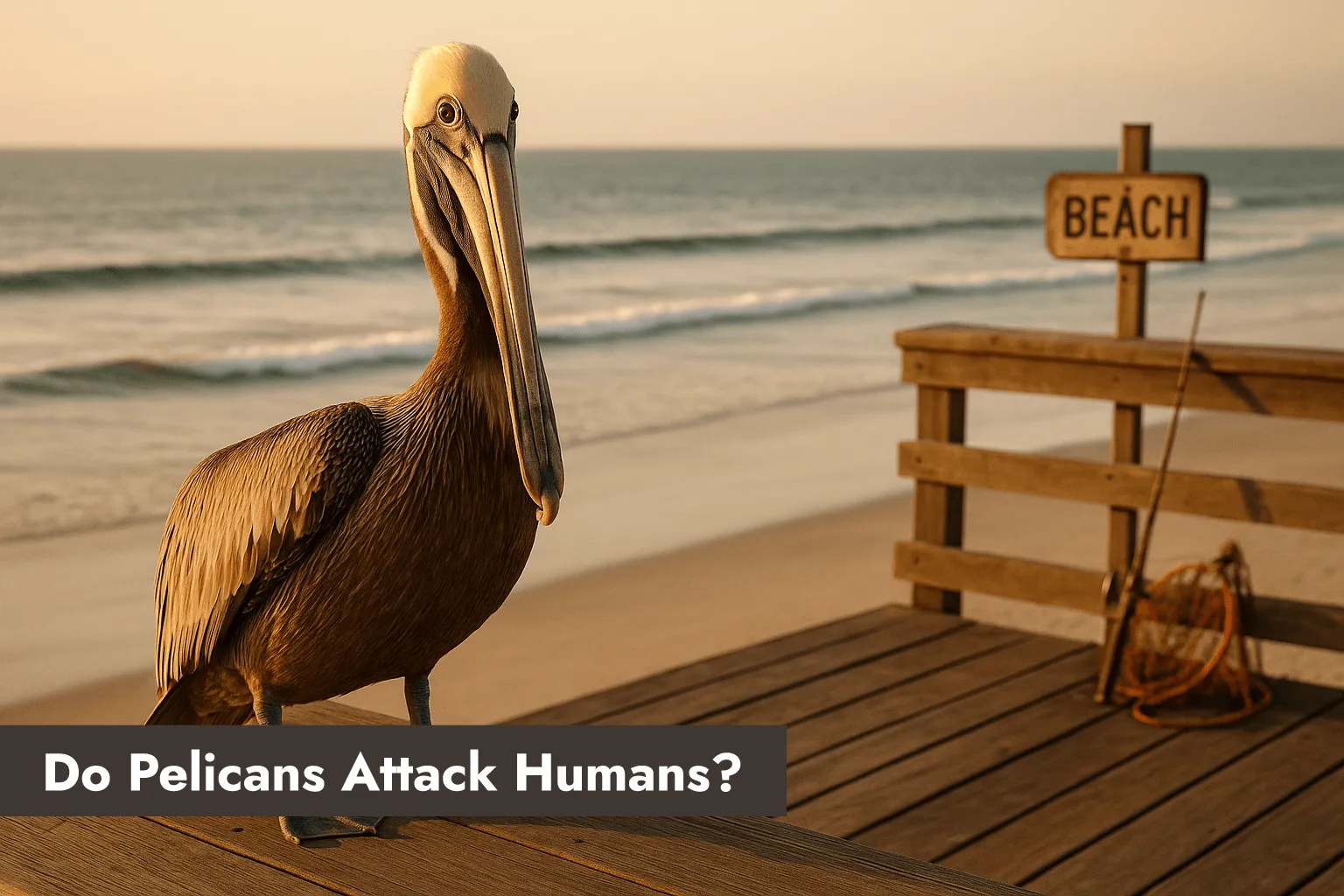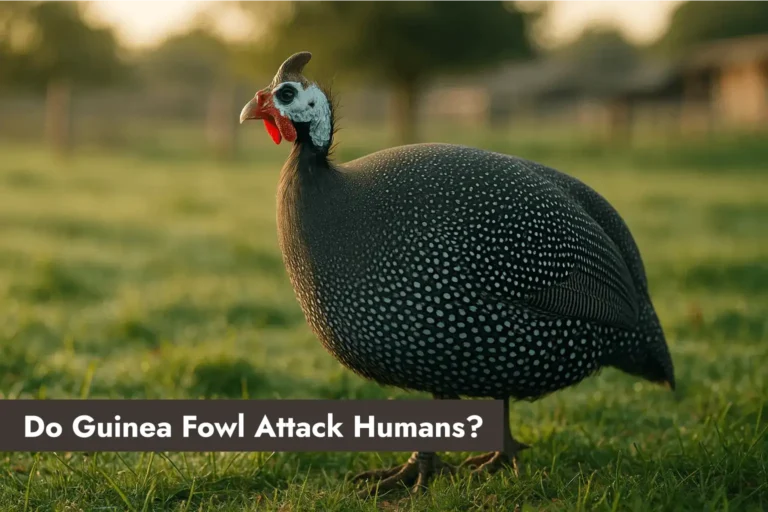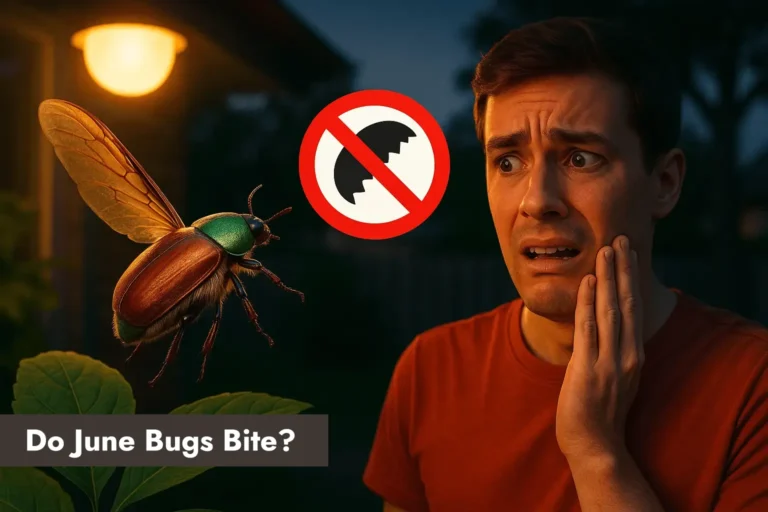Do Pelicans Attack Humans? Risks, Facts & Safety Tips
Quick Answer: Are Pelicans Dangerous to Humans?
Pelicans are not considered dangerous to humans, but like most wild animals, they can become defensive if they feel threatened, startled, or conditioned to associate people with food.
While pelicans have large, strong beaks and impressive wingspans, their behavior is typically non-aggressive and cautious around people. That said, there are a few situations where minor confrontations might happen, especially:
- If a pelican is fed regularly by humans and starts expecting handouts
- During nesting season, when they’re more territorial
- When someone gets too close, especially to a sick, trapped, or injured bird
These aren’t “attacks” in the traditional sense — more like quick pecks or lunges meant to warn, not harm. Injuries to people are extremely rare and usually mild (like a scratch or nip).
Think of them like seagulls with better aim — not hostile, but not domesticated pets either. It’s all about keeping a respectful distance.
Understanding Pelican Behavior
To understand whether pelicans might ever act aggressively, it helps to first look at how these birds behave in the wild. Pelicans are coastal, fish-eating birds known for their large bills and dramatic feeding dives—not for picking fights with people.
Pelican Personality 101
Pelicans are generally calm, social birds. They often travel, nest, and hunt in groups. If you’ve ever seen them lined up on a pier or gliding in formation over the waves, you’ve witnessed their cooperative nature. Despite their size and prehistoric look, they’re non-confrontational by default.
They spend most of their day doing one of three things:
- Fishing: Using their oversized pouches to scoop up fish, especially in shallow coastal waters.
- Resting: Lounging near harbors, beaches, or sandbars.
- Nesting: During breeding season, they form dense colonies—sometimes hundreds of birds—where they become a bit more protective.
Feeding Habits Can Lead to Human Conflict
One behavioral trait that occasionally causes issues? Opportunistic feeding. Pelicans are smart and can learn to associate people (especially fishers) with easy meals. A pelican hanging around a dock isn’t being aggressive—it’s hoping you’ll toss a snack its way.
This can lead to “begging behavior”, where a pelican might waddle closer, open its pouch, or snap its bill near food. It’s not meant to harm, but it can startle someone unfamiliar with the bird’s body language.
Different Species, Same Instincts
There are eight species of pelicans worldwide. The Brown Pelican (common in the U.S.) is the smallest but also the most frequently spotted near humans. Despite regional differences, all pelicans share the same instincts: fish, flock, and avoid unnecessary conflict.
Understanding these natural tendencies helps explain why pelican “attacks” are usually misunderstandings—not malice.
When and Why Might a Pelican Act Aggressively?
While pelicans aren’t aggressive by nature, there are situations where they might lash out defensively—especially if they feel cornered, threatened, or overly comfortable around people. These moments are rare, but understanding them can help you avoid an unpleasant run-in.
1. Defending Nests or Chicks
Like most wild birds, pelicans become territorial during breeding season. If you unknowingly get too close to a nesting site—especially on remote beaches, islands, or protected wildlife areas—a pelican may snap its bill, hiss, or lunge to protect its young.
- Example: A nature photographer in Louisiana once reported being pecked after stepping too close to a nesting colony while setting up gear.
- Tip: Stay at least 50–100 feet away from known nesting zones. Use binoculars or a zoom lens if observing.
2. Conditioned Feeding Response
Pelicans are smart and opportunistic. When humans feed them—whether at piers, beaches, or boats—they quickly learn to associate people with food. This leads to “food-aggression”, where they may approach assertively or snatch at bait, snacks, or even outstretched hands.
- Analogy: Think of a pelican like a seagull on steroids—bigger, bolder, and more likely to lunge if it thinks you’re holding a fish.
- Stat: Florida wildlife officials report dozens of minor “contact incidents” yearly between pelicans and recreational anglers—almost always tied to feeding.
3. Startled or Trapped Birds
If a pelican feels cornered, injured, or unable to escape, it might react out of panic. This includes snapping its bill, flapping wings, or making sudden movements that could scare or scratch a person nearby.
- Common around boat decks, docks, or rescue situations
- Always call local wildlife rescue if you encounter an injured pelican
4. Illness or Disorientation
Rarely, a pelican acting strangely or aggressively may be sick or disoriented, often from ingesting fishing hooks, plastic, or toxic fish. These birds might approach humans in confusion, appear unbalanced, or react unpredictably.
- These are not true “attacks”, but symptoms of distress
- Avoid contact and report to local wildlife authorities
Most pelican “aggression” isn’t truly aggressive—it’s a reaction to stress, conditioning, or defense. Staying respectful of their space and never feeding them goes a long way in preventing unwanted encounters.
Do Pelicans Have the Ability to Harm Humans?
At first glance, pelicans might look a little intimidating. With wingspans that can reach 6 to 10 feet (depending on species) and a long, hooked beak, it’s fair to wonder: Could a pelican actually hurt someone?
The short answer? Not really—at least not seriously.
Built for Fish, Not Fighting
A pelican’s most notable feature is its bill and throat pouch, which it uses like a fishing net. While that bill can snap shut with surprising force, it’s designed to catch slippery fish—not to bite or attack.
Here’s what pelicans can do:
- Peck or jab if they feel cornered or threatened
- Scratch or scrape with their beak or wings in a defensive reaction
- Flap forcefully, which could knock over a small child if caught off guard
But here’s what they can’t do:
- Break bones, deliver dangerous bites, or cause serious injury
- Attack unprovoked or pursue people with intent
What’s the Worst That Could Happen?
In rare cases, people have reported:
- Minor scratches or welts from a peck
- Small cuts from a beak snap, typically around hands or fingers
- Clothes getting snagged or pecked at if holding food
There are no documented cases of pelicans causing severe harm to humans. Wildlife officials and rescuers who handle pelicans regularly wear gloves for protection—not because the birds are vicious, but to avoid accidental nips during stress.
Respect = Safety
So, while pelicans do have the physical tools to cause minor discomfort, they’re not dangerous animals by nature. If you treat them with respect and distance, there’s virtually no risk of harm. Think of them like large, curious roommates at the beach—impressive, sometimes awkward, but not out to get you.
Real Stories: Have Pelicans Ever Attacked People?
While true pelican attacks on humans are extremely rare, there are a few odd—and often humorous—stories floating around the internet that spark curiosity. Most of these encounters fall into one of two categories: pelicans trying to get food or people getting too close for comfort.
The Viral Video: Pelican Tries to Eat a Man’s Arm
One of the most popular examples is a viral clip where a pelican playfully wraps its bill around a man’s arm as he sits on a bench. The bird doesn’t bite, flap, or chase—it just seems curious (and maybe a little too friendly).
- The man isn’t harmed; in fact, he laughs it off.
- Wildlife experts later explained the behavior as a mix of habituation and learned feeding response—the bird likely expected food, not a handshake.
Fishing Dock Incidents
In coastal towns like Clearwater, Florida or Santa Barbara, California, local fishers often report pelicans getting “pushy” near cleaning stations. Some have been pecked on the hand or had bait stolen mid-cast.
- In most cases, these birds are used to being fed and lose their natural caution.
- One Florida pier operator noted that pelicans “act bold when they think there’s a snack involved, but back off quickly if you shoo them.”
Photo Op Gone Wrong
There are also stories of beachgoers or photographers trying to get too close to pelicans for that perfect shot. In one case, a tourist in Australia reported getting nipped on the leg after cornering a pelican near its nest. No injury—just a bruised ego and a warning snap.
The Pattern: Misunderstandings, Not Malice
Across all these examples, one thing stands out: these aren’t attacks in the true sense. They’re moments of defensive behavior, food-seeking, or curiosity, usually provoked by human actions.
So yes, pelicans have interacted with people in ways that could startle or scratch—but calling it an “attack” is a stretch. If you give them space and skip the feeding, it’s highly unlikely you’ll be the star of the next viral pelican video.
How to Safely Observe Pelicans in the Wild
Pelicans are a joy to watch—graceful in flight, clumsy on land, and surprisingly cooperative when fishing in groups. If you’re exploring a beach, pier, or wildlife area, chances are you’ll spot a few. But to keep the experience safe for both you and the birds, it’s important to follow some simple wildlife observation guidelines.
Do’s and Don’ts Around Pelicans
Pelicans may look approachable, but they’re still wild animals. Here’s how to keep your distance while enjoying the view:
Do:
- Observe from 10+ feet away, especially during nesting or feeding
- Use binoculars or zoom lenses for close-up views and photography
- Watch their body language: fluffed feathers or open beaks may signal stress
- Dispose of trash and fishing line properly—entanglement is a serious threat to pelicans
Don’t:
- Feed pelicans—it conditions them to seek food from humans, leading to aggressive behavior
- Try to touch or pet them, even if they seem tame
- Chase or corner them for photos
- Let pets run loose around roosting birds
Tips for Families and Pet Owners
If you’re with kids or animals, stay especially mindful:
- Teach children that pelicans are not pets or performers
- Keep dogs leashed near shorelines or nesting zones
- Use signage (many parks have it) to identify protected areas where pelicans gather
Respectful Distance = Better Encounters
By keeping a respectful distance, you not only avoid the risk of being pecked or startled—you also give pelicans the space they need to thrive. Whether you’re snapping photos, fishing nearby, or just enjoying a beach walk, observing these majestic birds safely is one of the best ways to appreciate coastal wildlife.
Expert Insights: What Wildlife Experts Say About Pelican Aggression
To better understand whether pelicans pose any real threat to humans, we looked to the people who know them best: wildlife biologists, bird rescue workers, and coastal park rangers. Across the board, their message is consistent—pelican aggression is extremely rare, and almost always provoked.
“They’re Not Looking for Trouble”
According to Dr. Sarah Jennings, a coastal bird specialist with the U.S. Fish and Wildlife Service:
“Pelicans are generally passive. If they snap or peck, it’s nearly always a defensive behavior—like when they’re stressed, injured, or expecting food from a person.”
She adds that most complaints come from areas where tourists or fishers feed birds, which disrupts their natural wariness.
Insights from Rescue Teams
Staff at Pelican Harbor Seabird Station in Florida say that 99% of human-pelican interactions are harmless, but warn that handling or crowding a pelican can provoke a sharp reaction:
“We wear gloves not because they’re aggressive—but because scared birds use their beaks to protect themselves.”
What the Data Shows
- Reports of pelican-related injuries are extremely rare, with only a handful of minor incidents logged annually in high-traffic areas.
- The majority involve bait-stealing encounters or people approaching nesting sites.
Pelicans are non-aggressive by nature and pose virtually no threat to humans who treat them with respect. If anything, they’re more at risk from us than we are from them.
Common Myths About Pelicans and People
Because of their size and unusual appearance, pelicans often become the subject of wild stories and exaggerated assumptions. Let’s clear up a few common myths about pelicans and human interactions—some of which you may have heard on the beach, in social media videos, or even in casual conversation.
Myth: A Pelican Can Swallow a Human or a Pet
This one’s especially common with kids, thanks to their enormous throat pouch. While a pelican’s pouch can hold up to 3 gallons of water, it’s made for catching fish, not swallowing land animals.
- Truth: Pelicans eat fish, frogs, and small aquatic creatures—not dogs, cats, or people.
- Fun fact: They usually tilt their heads to drain water before swallowing prey whole.
Myth: Pelicans Are Friendly and Like Being Touched
While pelicans may seem docile when resting on piers or beaches, they are not domesticated animals and don’t enjoy human contact.
- Truth: Approaching or touching a pelican can stress it out and trigger a defensive reaction like pecking or flapping.
Myth: Feeding Pelicans Helps Them Survive
It might feel kind, but feeding wild pelicans does more harm than good. It changes their natural behavior, increases their reliance on humans, and leads to food-aggression or injury from human food or hooks.
- Truth: Most wildlife experts agree—“A fed pelican is a dead pelican” is more than a saying; it’s a warning.
Pelicans aren’t monsters, mascots, or pets. They’re wild animals with specific needs and instincts. Busting these myths helps ensure safer interactions—for both people and the pelicans we love to watch.
Conclusion: Respecting Wildlife While Staying Safe
So, do pelicans attack humans? The answer is: not intentionally, and almost never without cause. These unique coastal birds are curious, social, and occasionally bold—but they’re not aggressive by nature. Most so-called “attacks” are actually reactions to being fed, startled, or crowded.
If you’re lucky enough to spot pelicans in the wild, the best way to stay safe—and keep them safe—is to observe from a respectful distance. Don’t feed them, don’t touch them, and don’t treat them like pets or pests.
Think of pelicans as part of the beach’s natural rhythm: majestic in the sky, a little awkward on land, and endlessly fascinating to watch. By giving them space, you help preserve that peaceful relationship for future beachgoers, photographers, and wildlife lovers.
Respect the bird, enjoy the view—and everyone stays safe.
FAQs About Pelican Attacks and Safety
Have more questions about pelicans and how to safely enjoy their presence? Here are some of the most common queries people ask—especially when planning a beach trip, fishing outing, or family wildlife walk.
Yes, but it’s rare—and usually not intentional. Pelicans may snap their beaks if they feel threatened or are trying to grab food. It’s more of a warning or a food-grab than a true “bite.” At worst, you might end up with a small scratch or bruise.
Not in the traditional sense. Pelicans are calm and non-aggressive by nature, but they can react defensively if provoked—especially if someone gets too close to a nest, injured bird, or tries to feed them directly.
Feeding pelicans encourages them to approach people more boldly, sometimes leading to pecking or aggressive food-seeking. It also puts their health at risk, as human food and baited hooks can injure them. In some places, feeding pelicans is illegal and can result in fines.
It’s extremely unlikely. Pelicans may appear curious, but they do not view dogs or cats as prey. However, if a loose pet gets too close—especially near a nesting pelican—it might trigger a defensive peck or wing flap. Always keep pets leashed near wildlife.
No. Most beachgoers and fishers will never experience anything close to a pelican attack. When incidents do happen, it’s typically in heavily trafficked or feeding-prone areas, and usually involves food expectations or accidental provocation.
Stay calm, back away slowly, and avoid reacting loudly or with sudden movement. If the bird seems sick or entangled in fishing line, contact a local wildlife rescue or animal control center.




